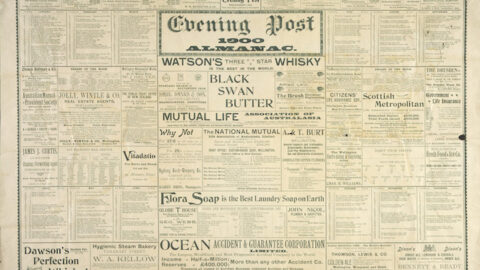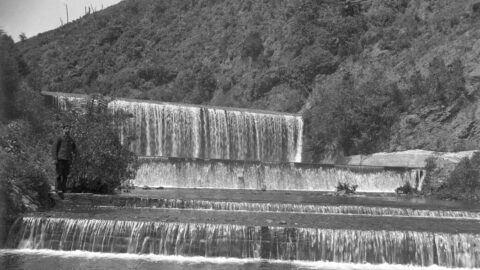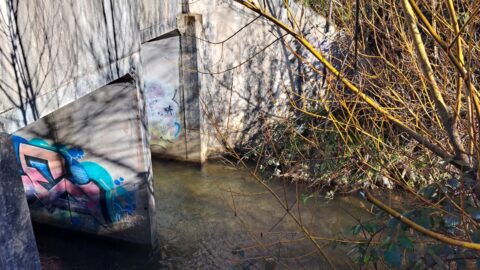SERIOUS DAMAGE TO THE WAINUI DAM.
BRIDGES WASHED AWAY.
The heavy and long-continued storm of rain from Sunday night till Tuesday noon caused another disastrous flood at Wainuiomata. This is the third destructive flood since the new waterworks were commenced, and this last flood seems to be the worst. All these misfortunes have happened while the contractor was engaged in his work, and, unfortunately for him, have occurred just when his work was approaching completion, thereby making the damage all the more costly to repair.
The rainstorm which caused this last flood was one of the longest and heaviest in recent years, and the sudden accumulation of flood-water in the Wainui reservoir was proportionately heavy. The congestion in the Wainui stream, swelling it to a river, became severe early on Tuesday morning, and reached its greatest pressure about 2 o’clock in the afternoon, when the flood level began to go down.
The contractor, Mr Bayliss, was expected to finish his contract work last Thursday week, and did finish about that time. He had afterwards to be responsible for two months’ maintenance of the works in complete order, so that he was not clear of risks when this deplorable flood swept away, for the third time, most of his costly work with the force of an avalanche.
The first damage had been caused by a tree getting into the temporary overflow flume, choking it till the water rose and washed out the backing of the dam when it was all but finished. This damage had to be repaired, at the contractor’s expense; and just when he had repaired the damage, and was almost ready for the second time to hand over the finished contract, there came a heavy flood and swept away the costly work that had been done to the dam.
Once again he had to tackle this desperate job of finishing the overflow dam, and this time he got the work actually finished, ready to hand over, when once again “the rains descended and the floods came,” sweeping away all, or nearly all, his patient labour. Such are the risks of contracting.
Mr Bayliss’s workmen had all but finished the dam last Thursday week. The slope which was to form the backing of the solid wall, built across the neck of the reservoir, had been concreted over the clay to a depth of 3½ ft, mixed with boulder stones, and over these were laid and “grouted” into the concrete other boulders of large size, to form an outer solid face. Judging from appearance, nothing could be more solid or irresistible, as a sloping face for flood water to flow over in wet weather.
It so happened, however, that one portion of this heavy boulder facing had been left till the last, at a corner near the place where carts crossed over to bring sand for the work. This last bit of facing was filled in late on Thursday, the liquid cement being poured into the interstices and left to harden. But, alas! before the stuff was quite solidified, the rain of Sunday night and Monday fell on the “green” work and spoilt it.
The reservoir began to overflow, and by Tuesday noon the flood rose so high that a torrent of overflow water covered the sloping dam to a depth of 11 ft. The rise higher up the stream was actually 15 ft to 16 ft. The force with which this volume of floodwater swept down the sloping dam may be imagined. Its scouring effect on the section of green concreting can also be conceived.
This new portion began to disintegrate. Then a boulder was loosened; another and another boulder got swirled away from the solid slope, and this gradual breaking up of the sloping dam resulted, after some hours of furious scouring, in the whole face of heavy boulders being washed away, besides the mass of clay “filling” behind the wall being also swept out as if it had never been there.
While the boulder facing of the dam was being wrecked—though not destroying the dam, because the solid wall remained uninjured—other destruction was going on. The contractor had cut a fluming as a temporary overflow while the dam was building; and when this was no longer required, he built up the narrow opening in the concrete wall, and filled in with earth the deep gutter flume.
But here again the work was too new to withstand a scouring flood, for the overflow crept round into the newly filled trench, swept out the loose earth, and soon scoured a deep trench, which caused the new piece of concrete wall to give way, and so form a new outlet from the flooded reservoir. The damage caused by this new outlet was serious, and the workmen’s huts were almost swept away. One hut was removed just in time to save it.
Evidences of the damage, as seen yesterday, were almost appalling. The heavy boulders seemed to have utterly disappeared, though they may have been swept down no further than the flat below the dam. The water was too high yesterday to show where the wreckage lay. A great quantity of timber had been washed down from the higher creeks, some trees being enormous in size.
The furious force of floods in the Wainui river is now terribly demonstrated. The water-pipes from the well where the river is turned into the reservoir will have to be taken up and re-laid, as the earthen support has been washed away, leaving the pipes hanging, and their joints broken. The “service” is thus disconnected for a time.
Mr Bayliss’s timber used in scaffolding has been washed away and scattered in all directions, causing additional loss to him. All the bridges over the Wainui stream in the valley, from the schoolhouse downwards, have been washed away. The road over the hill is cut into water ruts deep and dangerous. Evidences of the flood are everywhere.
Mr Baird, acting engineer for the City Council, visited the waterworks Wednesday, with the overseer and Mr Bayliss. The sight must have been saddening to the engineer as well as the contractor. A report was made to the Mayor last evening, after Mr Baird’s return, and a special meeting of the City Council has been summoned for this afternoon, to determine what action shall be taken in this emergency.
[Text continues in next message due to length…]
[Continued from previous message]
It had been decided at a special meeting of the City Council, held yesterday week to consider the matter of the bursting of the Wainuiomata dam or by-wash, that councillors should proceed to the scene of the disaster on Saturday.
Owing, however, to the fact that Mr Baird, the acting city engineer of the council, was free on Friday, and would, on account of his being required to give his attendance at the Supreme Court as a witness, be unable to accompany the councillors on Saturday, it was decided on Friday morning that so many city councillors as could be “warned” at so short a notice should proceed to the Wainuiomata dam without delay, and, shortly before noon, the municipal party, consisting of the Mayor, Councillors Danks, McKenzie, Maginnity, and Richardson, Mr Marten (Town Clerk), and Mr Baird, acting city engineer, left town.
Almost immediately the ascent of the hill was commenced, unmistakeable evidences of the recent heavy rainfall were apparent. The cart ruts, which heretofore had been in all conscience deep enough, became deeper still, and in many places the metal was washed completely off the track. It was not, however, until the party had left their vehicles and had commenced to ascend the valley along Sinclair’s old tramway that the devastations caused by the late flood were apparent.
About 200 yds from the old sawmill, and within a short distance of the valve leading from the well tunnel, several lengths of large main pipes are to be seen bent and hanging, as it were, with a good stiff freshet flowing over the middle, which now presents an ungraceful curve. The leaden joints have given way owing to the flood having eaten away the earth on which they originally rested, and another even moderately heavy fall of rain would sweep the pipes down the stream. The freshet has eaten under the pipes, and has formed quite a bay on the shore side. This, however, may be characterised as a casualty against which no engineering skill could guard against.
The violence of the late storms, however, is again apparent during the trudge up to the old tramway, nearly the whole of which is submerged with water, a stream ankle-deep flowing freely over it, except in places where recent landslips have covered the rails. To the right the Wainuiomata stream was flowing placidly, but evidences of the late storm were to be seen by hundreds of huge trunks of trees and other debris which had been left high and dry by the receding torrent.
The spectacle presented to the visitors at the face of the wall of the dam, and at the dam itself, was even more deplorable than was at first anticipated. A gulch or ravine—or, as the Americans would call it—a canon, about 130 ft long, 30 ft wide, and about the same distance in depth has been torn through a neck of land separating the face wall from the stream. It is at this spot that the greatest amount of the damage is to be seen, although, perhaps, it was not here the commencement of the disaster occurred.
The concrete wall, so far as Mr Bayliss’s contract is concerned, is a thing of the past. The wall and channel has disappeared and the stream has swept the boulders and concrete—the work of months—down stream. Where the torrent has swept the channel the walls of the concrete show thin and sandy, and the slightest touch of the foot crumbles it into dust.
In all fairness to the contractor, the city engineer, and Mr Donald Sinclair, the overseer of the works for the City Council, it should be stated that the particular work to which we at present allude is quite green, and was only finished on last Wednesday week; but, even taking this short period since the work was completed into account, the concrete at this point seems so rotten that to a layman it looks as if it would never stand, even supposing it was exposed for a period of ten thousand years. It lacks cement, and, when this is said, all is said.
Alongside Mr Bayliss’s contract, at the face wall, and covering the main outlets and the by-wash, is Mr Sinclair’s contract, which is similar in all respects, so far as the specifications are concerned, to that just completed by Mr Bayliss. But here all similitude must cease. Mr Sinclair’s contract has been well and faithfully carried out. The material used is good, and the work is as firm as solid masonry.
Mr Bayliss’s work, allowing for its greenness, speaks for itself. Upon the hand touching it, it crumbles away like the sand from an hour-glass, “and leaves not a wrack behind.”
[Continued in next message…]
[Final part]
The cause of the breakage in the face wall would appear to have been that the contractor, in order to complete the dam proper—which it must be understood is quite distinct from the face wall where the by-wash is—cut a flume from the face wall through the little peninsula or neck of land to let the water out, so as to enable him to build up and cement the dam.
Mr Baird asserts most positively that he not only never authorised Mr Bayliss to cut the flume in question, but knew nothing of it till the evil had been wrought, or at any rate so far perfected that it would have been idle to have protested. And here it may be as well to remark that Mr Baird states that he has not given Mr Bayliss a final or “clean” certificate.
Mr Baird visited the scene of operations on last Wednesday week, and, finding the work incomplete, he was neither asked nor did he for a single instant think of giving the contractor a final certificate. Several pieces of the concrete from the face wall just erected by Mr Bayliss were taken away by the councillors present, but they very speedily melted away, and were seen no more.
The visitors next proceeded to the dam, and the devastation caused by the late flood was at this point even more apparent than at the face wall. Here, within four hours’ time, the labour and skill of months have been destroyed. The sight was really a most distressing one. Hundreds of tons of what a few days since was solid concrete has been swept away, and all that remains to be seen is a few cartloads of boulders lying in the old course of the stream.
The dam was constructed so that it should be an overflow, and every care, both on the part of the city engineer and the contractor, Mr Bayliss, appears to have been concentrated on the work, or at any rate that portion of it which is left, and that, in all conscience, is very little, the water having made a clean sweep of everything on the overflow side of the dam, with the exception of a narrow inclined strip of concrete, about six feet wide, on the southern side of the dam.
The construction of this is somewhat peculiar, and consists of a steep incline, composed of heavy boulders, with “grout” or cement pressed closely into the interstices. This cement work was about fifty yards wide, and all of it, with the exception of the narrow strip above mentioned, has disappeared—not swept away, be it remembered, by a mountain torrent, as in the case of the face wall and the chasm or fissure already referred to, but insidiously eaten, or rather washed away, bit by bit and morsel by morsel, till the entire structure—if so it may be designated—fell, and was engulfed.
The theory for the destruction of this overflow way is that the water “lapped up” the foot or the bottom of the concrete, which was quite new, and gradually ate it away; and once a breach was made, the remainder of the work of destruction was easy of accomplishment. The floodwater rose still higher and higher, and getting behind the concrete on the hillside, it gradually scoured the wall away, and, had the concrete been the best ever, it would have been unable to resist the flood. The evil was done. The foot of the concrete slope was green, and the water was allowed to flow over the dam and break it.
But while admitting that the strip of concrete which is left is good work, and may probably be a fair sample of the work which has been swept away, the same remark cannot be applied to the concrete work on the top of the dam, especially on the coping on the other side of the dam. Some of the work which the acting engineer informed the Mayor was at least two months old, and which, consequently, should have been dense and hard, crumbled into dust at a slight kick on the part of Mr Fisher.
“Do you call this good concrete, Mr Baird?” said his Worship.
“No; I do not,” responded the acting engineer, “but I know good materials were supplied, and I know that Mr Sinclair was overlooking the work every day, and I am sure he can be trusted. I was not able to be out here every day.”
Councillors Richardson and McKenzie, accompanied by Mr Baird, then retraced their steps to the wall face, and broke off a mass of concrete from the bed of the rock. This was a piece of concrete which had been in position for six months, and was tolerably hard. It was marked by the Mayor and the councillors mentioned, and was brought into town for future reference.
Considerable disappointment was evinced by the councillors who were present that Mr Blackett, Government engineer, was not present in answer to an invitation, but it was explained that business engagements prevented that gentleman from attending. It was intimated, however, that Mr Blackett would visit the scene of the catastrophe the next Monday.
During the day, and in an answer to a question propounded by a councillor, Mr Baird considered that the damage could be repaired for about £1500. Councillors, however, shook their heads, and remarked that in their opinion it would take at least £4000 to put the works in good working order.
The party returned to town about 7 o’clock.
Tags: Floods Newspaper Water Race Waterworks







